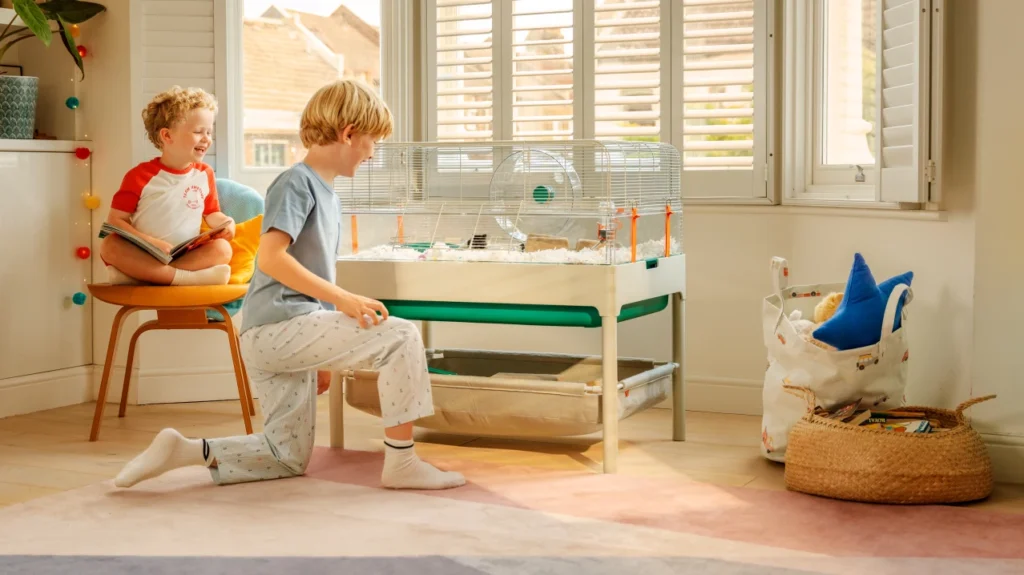Large Hamster Cages: If you’ve ever watched your hamster run around, burrow, or climb on toys, you know they’re incredibly active. That’s why choosing a large hamster cage is one of the most important decisions you can make for your little companion.
In this guide, we’ll break down the benefits of large cages, what features to look for, and recommend some ideal options that keep your pet safe, stimulated, and happy. If you want to find about Large Hamster Cages you are on right place no need to search on internet about Large Hamster Cages now you know the best guide on Large Hamster Cages so lets dive in…
Table of Contents
Why Large Hamster Cages
Hamsters may be tiny, but they need plenty of space to explore. A small, cramped cage can lead to stress, boredom, and even health issues. Here’s why size matters:
1. Room to Explore
Hamsters love to roam. In the wild, they can travel miles at night. A spacious cage lets them follow their instincts with more freedom.
2. Space for Enrichment
A larger cage means more room for tunnels, wheels, platforms, and toys, which are all essential for mental and physical stimulation.
3. Improved Hygiene
With more room, you can create separate zones for sleeping, eating, and using the bathroom, which helps keep the cage cleaner longer.
Recommended Minimum Size
Experts recommend that hamster cages be at least 450 square inches of unbroken floor space — but larger is always better.
| Hamster Type | Minimum Floor Space |
|---|---|
| Syrian Hamster | 600+ sq in |
| Dwarf Hamster | 450+ sq in |
Keep in mind: vertical space is great for climbing, but horizontal space is the most important.
Key Features to Look for in Large Hamster Cages
Not all cages are created equal. Here are the most important factors when choosing a large cage:
1. Solid Bottom (No Wire Flooring)
Hamsters have delicate feet. Wire floors can cause injury or “bumblefoot.” Always go for a solid surface base.
2. Secure Doors and Locks
Hamsters are escape artists. A large cage should have tight-fitting doors and secure latches.
3. Ventilation
Good airflow prevents mold and odors, especially if you use deep bedding for burrowing.
4. Deep Base for Digging
Hamsters love to dig. Look for a cage that allows at least 6 inches of bedding depth.
5. Multiple Access Points
Larger cages often come with more doors or removable tops, which make cleaning and handling easier.

Popular Types of Large Hamster Cages
Here’s a quick comparison of the most common styles of large cages:
| Cage Type | Pros | Cons |
|---|---|---|
| Glass Aquarium | Great visibility, deep bedding | Heavy, poor ventilation |
| Wire with Plastic Base | Lightweight, good airflow | Watch for bar spacing (≤0.5 inch) |
| DIY Bin Cages | Affordable, customizable | Needs tools and time to build |
| Modular/Tunnel Cages | Fun to look at, colorful | Often too small, hard to clean |
Top 3 Large Hamster Cage Picks
1. Prevue Pet Products Universal Small Animal Home
- Over 600 sq in of floor space
- Deep base for burrowing
- Secure wire design with good airflow
2. Living World Deluxe Habitat
- Multiple sizes, including extra-large
- Easy access top and side doors
- Great for Syrian hamsters
3. DIY Ikea Detolf Cage
- Popular in the hamster community
- Budget-friendly with massive space
- Requires some DIY effort
Setting Up Your Large Hamster Cage
Once you’ve picked the perfect large cage, make sure it’s set up for comfort and health:
- Add at least 6 inches of soft bedding like paper-based material.
- Include a solid running wheel (8–12 inches, depending on hamster size).
- Place hiding huts and tunnels for security and enrichment.
- Offer chew toys and climbing platforms to keep your hamster active.
Common Mistakes to Avoid
- Using scented bedding – It can irritate their lungs.
- Buying multi-level cages with no floor space – Floors matter more than height.
- Neglecting deep bedding – Burrowing is a natural behavior.
Final Thoughts: Happy Hamsters Need Space
Choosing a large hamster cage is one of the best things you can do for your furry friend. Not only does it promote exercise and mental stimulation, but it also helps prevent health problems down the line.
Whether you go for a ready-made cage or a custom DIY bin, prioritize space, safety, and comfort. A happy hamster is an active one — and with the right cage, they’ll thrive!
FAQs
Q1: Can I keep two hamsters in one large cage?
No. Most hamsters, especially Syrians, are solitary and will fight if kept together.
Q2: How often should I clean a large hamster cage?
Spot-clean daily and deep clean every 1–2 weeks, depending on size and number of pets.
Q3: What’s the best bedding for a deep base?
Use paper-based, unscented bedding. Avoid pine or cedar shavings.
Q4: Are modular cages with tubes good for hamsters?
Most are too small and hard to clean. They look fun but don’t meet hamster needs.
Want to find more about pet products click here to find out.



